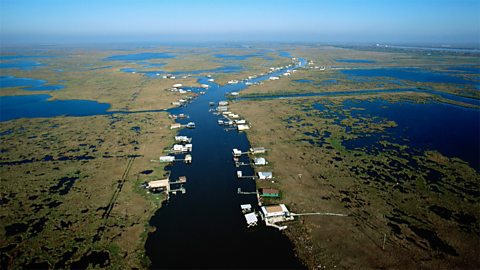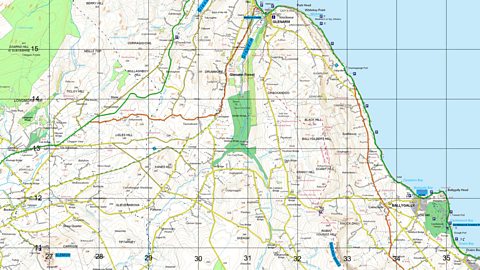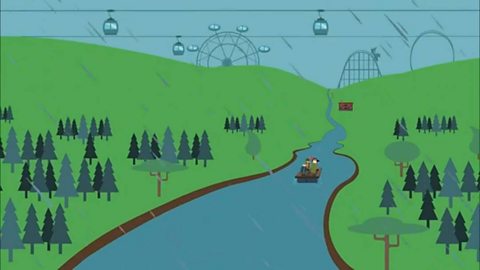Overview - Erosion
Rivers can reshape the landscape through processes of erosion and the transport and deposition of materials.
Erosion
Erosion involves the wearing away of rock and soil found along the river bed and banks.
erosionThis takes places when parts of the river bank or river bed are worn away and are removed from the landscape. also involves the breaking down of the rock particles being carried downstream by the river.
The four types of river erosion
Hydraulic action - the pressure of flowing water against the channelÔÇÖs bed and banks, gradually wears them away.
Abrasion/Corrasion ÔÇô the force of the water armed with stones and other materials grinds the channel like a piece of sandpaper.
Solution/Corrosion - soluble particles are dissolved by river water that is slightly acidic.
Attrition - rocks carried by the river crash together and break into smaller, smoother and more rounded particles.
Transportation
Rivers pick up and carry material as they flow downstream.
solutionWhen some rocks (like limestone) are easily dissolved by the water and the tiny particles of rock are held up within the water (transportation). - minerals are dissolved in the water and carried along in solution (in the water).
suspensionWhen the velocity of the water increases, the river can pick up larger pieces of stones and can carry them in the flow of water so that they do not make contact with the river bed (transportation). - fine light material is carried along in the flow of the water.
saltationWhen heavier particles are not held up but instead they are bounced along by the flow of water ÔÇô hitting the river bed (transportation). - small pebbles and stones are bounced along the river bed.
tractionWhen some of the heaviest stones in the river are rolled along the river bed. Stones and boulders usually can only be moved when the river has a lot of water moving quickly (transportation). - large boulders and rocks are rolled along the river bed.
When energy levels are high, larger rocks and boulders can be transportationThis takes place when eroded material in the river is moved from one place to another by the water in the river.. Near the riverÔÇÖs sourceWhere the drops of water come together to start a river., although the river velocity appears high due to gravity, contact with the narrow and shallow channel and the larger load in the river means velocity is reduced due to friction. Therefore energy levels are reduced.
The exception is during times of flood, when velocity increases and friction is overcome due to higher energy levels.
Near the mouth, energy is at its peak due to reduced friction. The wide and deep channel has reduced contact with banks and bed and load is often suspended, which means the river has increased energy. However, as a river enters a lake or sea, the energy levels will drop.
Deposition
depositionThis takes place when the river load is too heavy for the river to carry and material is dumped (or deposited) within the river channel. happens when a river loses energy. Deposition may take place when a river enters an area of shallow water or when the volume of water decreases - for example, after a depositionThis takes place when the river load is too heavy for the river to carry and material is dumped (or deposited) within the river channel. or during times of drought.
Deposition is common towards the end of a river's journey, at the mouthThe place where a river meets the sea..
Deposition at the mouth of a river can form deltasA river landform made of deposited sediment at the mouth of a river. - for example, the Mississippi Delta.

The three main types of processes that occur in a river.
Test yourself
More on River environments
Find out more by working through a topic
- count3 of 5

- count4 of 5

- count5 of 5

- count1 of 5
